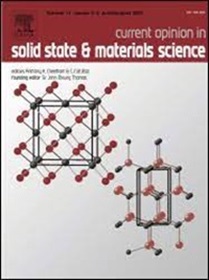Proposed relaxed criteria for fusion-activated materials
IF 13.4
2区 材料科学
Q1 MATERIALS SCIENCE, MULTIDISCIPLINARY
Current Opinion in Solid State & Materials Science
Pub Date : 2025-07-01
DOI:10.1016/j.cossms.2025.101229
引用次数: 0
Abstract
The advancement of fusion energy, heralded as an innovative, environmentally sustainable, and clean alternative to traditional energy sources, necessitates a comprehensive reevaluation and enhancement of the standards and criteria used to assess the suitability of materials for fusion reactors. This study underscores the reforming and simplifying of the current regulatory framework applicable to activated materials for fusion energy. It highlights the unique environmental properties inherent to plasma systems, requiring the adoption of materials that may not fully align within an established conventional regulatory framework. Existing systems and structures governing regulations and compliance, largely modeled on the rules and standards established for fission reactors, may impose excessively stringent constraints that could impede the advancement and innovation of new technologies. In addition, fusion systems would produce significantly less long-term (>100,000 years) radioactive waste per unit energy generated than fission systems, so the existing regulatory framework based upon fission systems is unnecessarily conservative. By implementing a comprehensive framework that thoroughly accounts for the unique properties and behaviors of radionuclides, along with a detailed assessment of the environmental impacts of different materials, innovation can be responsibly advanced while maintaining safety standards and adherence to regulatory requirements. A judicious and restricted use of activated materials is recommended by the integration of advanced waste management strategies and a comprehensive understanding of these materials during operating conditions. Studies show that several activated products from candidate materials for fusion applications will not meet the existing strict activity limits, either as the main elements or as additions. For example, only about 7.1 % of the blanket’s front wall tungsten volume in the Steady State Tokamak Reactor (SSTR) could generate 2,000 times the amount of 192nIr above the allowed limit. The regulatory framework should consider relaxing the criteria for fusion-activated materials by allowing higher activity levels, as the fusion waste decays rapidly and most materials require isolation periods of less than 100 years. The proposed relaxed criteria achieve a balanced integration of optimal performance, enhanced safety measures, and environmental sustainability, thereby promoting the development and adoption of fusion technology as a reliable and viable energy source for the future.
提议放宽核聚变激活材料的标准
作为一种创新的、环境可持续的、清洁的传统能源替代品,核聚变能源的发展需要对核聚变反应堆材料适用性的评估标准和标准进行全面的重新评估和加强。这项研究强调了改革和简化当前适用于聚变能活性材料的监管框架。它强调了等离子体系统固有的独特环境特性,需要采用可能不完全符合既定传统监管框架的材料。管理规章和遵守情况的现行制度和结构,主要以为裂变反应堆制定的规则和标准为蓝本,可能施加过分严格的限制,阻碍新技术的进步和革新。此外,与裂变系统相比,聚变系统产生的每单位能量产生的长期(10万年)放射性废物要少得多,因此,现有的基于裂变系统的监管框架是不必要的保守。通过实施一个全面的框架,彻底解释放射性核素的独特特性和行为,以及对不同材料的环境影响进行详细评估,可以在保持安全标准和遵守监管要求的同时负责任地推进创新。通过整合先进的废物管理策略和在操作条件下对这些材料的全面了解,建议明智和限制使用活性材料。研究表明,用于核聚变应用的候选材料的几种活化产物,无论是作为主要元素还是作为添加剂,都不能满足现有严格的活性限制。例如,在稳态托卡马克反应堆(SSTR)中,仅约7.1%的包层前壁钨体积就能产生超过允许限制的2000倍的192nIr。监管框架应考虑放宽核聚变激活材料的标准,允许更高的活度,因为核聚变废物衰变迅速,而且大多数材料需要不到100年的隔离期。拟议放宽的标准实现了最佳性能、增强的安全措施和环境可持续性的平衡整合,从而促进融合技术的发展和采用,作为未来可靠和可行的能源来源。
本文章由计算机程序翻译,如有差异,请以英文原文为准。
求助全文
约1分钟内获得全文
求助全文
来源期刊

Current Opinion in Solid State & Materials Science
工程技术-材料科学:综合
CiteScore
21.10
自引率
3.60%
发文量
41
审稿时长
47 days
期刊介绍:
Title: Current Opinion in Solid State & Materials Science
Journal Overview:
Aims to provide a snapshot of the latest research and advances in materials science
Publishes six issues per year, each containing reviews covering exciting and developing areas of materials science
Each issue comprises 2-3 sections of reviews commissioned by international researchers who are experts in their fields
Provides materials scientists with the opportunity to stay informed about current developments in their own and related areas of research
Promotes cross-fertilization of ideas across an increasingly interdisciplinary field
 求助内容:
求助内容: 应助结果提醒方式:
应助结果提醒方式:


